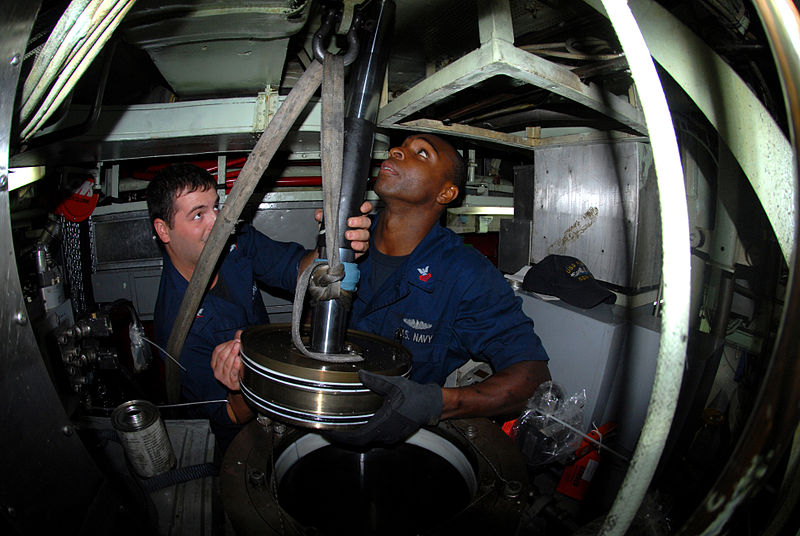Machinist’s Mates (MM) perform the task of the operation and maintenance of not only steam turbines and gears for ship propulsion but also the auxiliary machinery.
Additionally, they maintain refrigeration plants, desalinization plants, electrohydraulic steering engines, and air conditioning systems.
The Machinist Mate rate dates back to the US Navy since 1880. At that time, they were referred to as the Finisher rate.
In 1884, it was renamed to Machinist. In 1895, it was reverted back to the Finisher rate.
Finally, in 1904, the rate was given the name that ultimately stuck, Machinist’s Mate (MM).
The Boiler Technician (BT) rate merged with the Machinist’s Mate rating in 1996.
Related Article – Navy Aviation Structural Mechanic (AM): Career Details

MMs have a number of specialties, these include:
- MM – Machinist’s Mate
- MM/SS – Machinist’s Mate – Submarine Qualified
- MM(A)(P) – Machinist’s Mate (A) (Photographic)
- MM(O) – Machinist’s Mate (Optician)
- MM(SRE) – Machinist’s Mate (Ship Repair) (Engine Operator)
- MM(W) – Machinist’s Mate (Weapons) Previously Torpedoman Mate
- MML – Machinist’s Mate (General)
- And many others
Of these, we will also address the MM(N) – Machinist’s Mate (nuclear) rate.
A brief overview to determine the difference from the Aviation Machinist’s Mate (AD) will also be included.
Related Article – Marine Corps Mechanics (MOS 3521)
Jump To A Section
Requirements and Qualifications
To become a Navy Machinist Mate, there are specific requirements and qualifications that one must meet:
- Must be a member of the US Navy.
- U.S. citizenship is not required (unless a submarine volunteer).
- No security clearance is required.
- Must be between the ages of 18 and 39.
- Must have no record of adversely adjudicated drug abuse offenses.
- Must have normal vision.
- Must have normal hearing.
- Must have an Armed Forces Vocational Aptitude Battery (ASVAB) score of VE (Verbal Expression) + AR (Arithmetic Reasoning) + MK (Math Knowledge) + AS (Auto Shop) = 188 or VE (Verbal Expression) + AR (Arithmetic Reasoning) + MK (Math Knowledge) + AO (Assembly Objects) = 193.
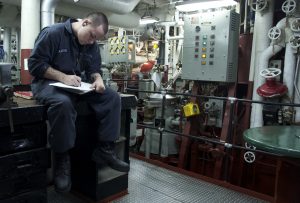
Related Article: Navy Height And Weight Standards
Training and Career Path
Prior to becoming a Navy Machinist’s Mate, you must first become a US Navy Sailor. Recruits accomplish this via successful completion of Navy Recruit Training, commonly referred to as Boot Camp.
All sailors attend Boot Camp at the Recruit Training Command, Great Lakes (RTC Great Lakes).
Located at Naval Station Great Lakes in North Chicago, Illinois in Lake County. RTC Great Lakes is commonly referred to as “The Quarterdeck of the Navy.”
Boot Camp is eight weeks long. During these eight weeks, the Navy teaches future seaman, airman, and fireman the basic skills required of all US Sailors.
Navy Machinist’s Mate Technical Class “A” School
After Boot Camp, future MMs attend Basic Engineering Common Core and “A” School at Great Lakes, Illinois. The school is nine weeks long and consists of Group instruction in a classroom and shop.
Specifically, the course consists of:
- Introduction to Technical Documentation
- Basic Mechanical Theory
- Safety Precautions and Programs
- Alignment and Operation of Piping Systems and Equipment
- Safe and Proper Handling and Operation of Hand Tools, Precision Instruments, Lubricants, Bearings, Couplings, Gears, Valves, and Pumps
- Course Instruction to the Maintenance Material Management System (3M)
- Basic Watch Standing Procedures
- Basic Technical Knowledge, Terminology and Watch Standing Procedures for the Operation of Conventional Marine Steam Propulsion Systems
- Preventive Maintenance of Plant Equipment
Machinist’s Mates (Nuclear), or MMNs attend the three-month-long Nuclear Field Class “A” School in Charleston, South Carolina.
Related Article – Navy Jobs List: A List Of All 71 Ratings In The Navy
Subjects include:
- Mathematics
- Physics
- Thermodynamics
- Mechanical Theory
- Fluid Flow
- Safety
- General Engineering Maintenance, Hand Tools and Test Equipment, Valves, Piping Fittings, Bearings and Lubrication, Pumps, Steam Turbines, Reduction Gears, Heat Exchanges, Condensers, Air Ejectors, Air Compressors, Refrigeration, Air Conditioning, and Evaporators
- Propulsion Plant Piping Systems Overview
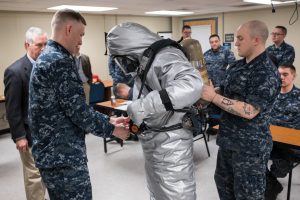
MMNs must also go through the six-month-long Nuclear Power School in Charleston, as well as the equally six-month-long Nuclear Power Training Unit with locations in both Charleston and Ballston Spa, New York.
Advanced technical training is available to Machinist’s Mates during the later stages of their career development.
Related Article – Army Avionic Mechanic (MOS 15N): Career Details
How Much Are Machinist’s Mates Paid?
Like all other enlisted personnel (in all branches), a Machinist Mates pay is based on their rank and length of service.
Navy Machinist’s Mates may be entitled to other forms of compensation including base allowance for housing (BAH), base allowance for subsistence (BAS), and billet pay (sea pay, hazardous duty pay, etc.) if eligible.
Typical Rotation
Sailors in specific jobs (or rates as the Navy refers to them) must adhere to a Sea/Shore rotation based on their rate.
The Machinist’s Mate should get used to the smell of saltwater and the rock and roll of shipboard life. This rate, surprisingly (perhaps only to me) is the most sea-intensive rates in the US Navy that I know of.
During a twenty-year career in the Navy, a Machinist Mate will spend about 70 percent of their career at sea, and only 30 percent assigned to shore stations, according to cool.navy.mil.
Specifically, the Sea/Shore Rotation for an MM is:
| Tour | Sea Tour | Shore Tour |
|---|---|---|
| First Tour | 60 Months (5 Years) | 36 Months (3 Years) |
| Second Tour | 48 Months (4 Years) | 36 Months (3 Years) |
| Third Tour | 48 Months (4 Years) | 36 Months (3 Years) |
| Fourth Tour | 42 Months (3.5 Years) | 36 Months (3 Years) |
| Fifth Tour | 36 Months (3 Years) | 36 Months (3 Years) |
| Sixth Tour | 36 Months (3 Years) | 36 Months (3 Years) |
| Seventh Tour | 36 Months (3 Years) | 36 Months (3 Years) |
Note that some overseas assignments count as sea tours.
Shipboard life and life on shore duty are drastically different. The Navy expects Machinist’s Mates, as they do all their sailors, to adapt and meet the challenges presented by these different environments.
Related Article – How To Get Into The US Naval Academy: 5 Challenging Steps
What’s Life Like as a Navy Machinist’s Mate?
A Machinist’s Mate not only operates and maintains a ship’s steam turbines and reduction gears used for propulsion.
They also work on and help maintain auxiliary types of machinery like turbo generators, pumps, and oil purifiers.
MMs are also responsible for the maintenance of machinery outside of main machinery spaces, such as electro-hydraulic steering engines and elevators, refrigeration plants, air conditioning systems, and desalinization plants.
In some cases, they may also operate and maintain compressed gas producing plants.
Machinist’s Mates normally work within the hull of a ship in locations such as boiler rooms, engine rooms, fire rooms, or shops.
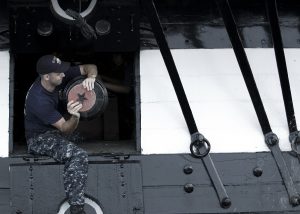
Often these locations are hot and noisy.
Machinist Mates often do heavy physical work.
They must not only be able to work closely with others, but they should also be able to work with limited supervision.
Duties of a Machinist Mate include:
- Aligning piping systems for oil, water, air, and steam, and controlling the operation of ship boilers and steam turbines used for ship propulsion and service systems.
- Controlling operation of turbo generators used to produce electrical power.
- Cleaning, adjusting, testing and performing other preventive maintenance on the ship’s boilers, main engines, turbo generators and other auxiliary machinery (including steering engines, elevators, winches, pumps, and associated valves).
- Operating and maintaining desalinization plants (distilling plants) to make freshwater from seawater.
- Maintaining refrigeration plants, air conditioning systems, and galley equipment.
- Repairing or replacing valves, pumps, heat exchangers, compressors, steam turbines, and hydraulic or pneumatic control devices.
- Making entries in and analyzing machinery operating records and reports.
Here are a few reviews featured on indeed.com from ex- and current Navy MMs:

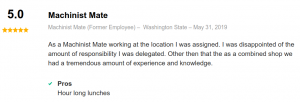


Machinist’s Mates enjoy the same benefits as do all Navy personnel, such as the opportunity to travel the world, unlimited opportunities for learning and advancement, and control over their career.
Approximately 6,300 men and women serve as Machinist’s Mates in today’s Navy.
MMs should not be confused with Aviation Machinist’s Mates (ADs).
Related Article – Navy Fire Controlman (FC): Career Details
Aviation Machinist’s Mates (AD)
Aviation Machinist’s Mates (AD) are mechanics who work on the Navy’s aircraft engine. ADs inspect, adjust, test, repair and overhaul aircraft engines and propellers, as well as perform routine maintenance, prepare aircraft for flight and assist in handling aircraft on the ground.
Specifically, ADs
- Maintain and service aircraft engines, fuel and lubrication systems.
- Handling and service aircraft both ashore and afloat.
- Perform complete aircraft turboshaft/turboprop engine repair.
- Determine reasons for engine degradation via spectrometric oil analysis tests.
- Evaluate jet engine performance, using jet test cells for fixed turbojet engines.
- Perform helicopter maintenance, installing and maintaining engines, drive accessories, and gearboxes.
- Perform propeller repairs.
- Function as aircrewmen in various types of aircraft.

AD Core and Strand “A” School is 6 weeks long (4 weeks – Core, 2 weeks – Strand) and is located in various locations:
- Pensacola, Florida
- Lemoore, California
- Virginia Beach/Norfolk, Virginia
- San Diego, California
- Whidbey Island, Washington
- Jacksonville, Florida
- Tinker, Oklahoma
There are about 5,100 ADs serving in the Navy today.
Related Article – Dishonorable Discharge: Reasons, Consequences, And More
Civilian Career Opportunities
A good Machinist’s Mate will never be short of civilian career opportunities. These opportunities include civilian operating engineer, HVAC technician, and non-nuclear power plant jobs. MMNs, of course, are qualified and highly sought after for nuclear power plant jobs.
Like all sailors, MMs should take full advantage of on-the-job training (OJT), other unique training opportunities, and educational opportunities offered and afforded them during their naval service.
The United States Military Apprenticeship Program (USMAP) also allows MMs to complete their civilian apprenticeship requirements while on active duty.
According to cool.navy.mil, these apprenticeships include:
- Computer Operator
- Correction Officer (Government Service)
- Counselor (Professional & Kindred)
- Hydroelectric-Machinery Mechanic (Utilities)
- Maintenance Mechanic (Any Industry)
- Pipe Coverer And Insulator
- Power-Plant Operator (Utilities)
- Pump Repairer (Any Industry)
- Refrigeration Mechanic (Any Industry)
- Water-Treatment-Plant Operator (Waterworks)
If you are considering the US Navy, are good with your hands, not afraid of physically challenging work in locations that are often hot and noisy, and are seeking adventure, a career as a Navy Machinist Mate might just be for you.
Related Article – Pros and Cons Of Joining The Navy
References
Official Navy Page for Machinist’s Mate
Indeed.com Reviews for Machinist’s Mate
Navy COOL Summary For Machinist’s Mate (MM)
Navy COOL Summary for Aviation Machinist’s Mate (AD)
- Gas Turbine Systems Technician (GSM and GSE): Career Details - June 18, 2024
- Interior Communications Electrician (IC): 2023 Career Details - June 18, 2024
- Religious Program Specialist (RP): 2023 Career Details - June 18, 2024
General FAQ
What does a Machinist Mate do in the Navy?
A Navy Machinist Mate operates and maintains steam turbines, gears, and auxiliary machinery for ship propulsion.
What is a Navy Nuclear Machinist Mate (MMN)?
A Navy MMN is a Machinist Mate who works on the nuclear power generation systems on aircraft carriers and submarines.
What ASVAB score do you need to be a Navy Machinist Mate?
To qualify for Machinist Mate, you need a VE (Verbal Expression), AR (Arithmetic Reasoning), MK (Math Knowledge), and AS (Auto Shop) total of 188. Alternatively, you qualify with a VE, AR, MK, and AO (Assembly Knowledge) total score of 193.
How long is a school for a Machinist Mate?
Training to become a Navy Machinist Mate is nine weeks long and is held at Great Lakes, Illinois. Training as a Nuclear Machinist Mate includes 12 additional months of advance training.
How much does a Machinist Mate make?
Like all military branches, the Navy pays Machinist Mates according to rank and time in service. Currently, a new recruit makes a monthly base pay of $1,733 per month. Nuclear Machinist Mates may be eligible for enlistment bonuses.

